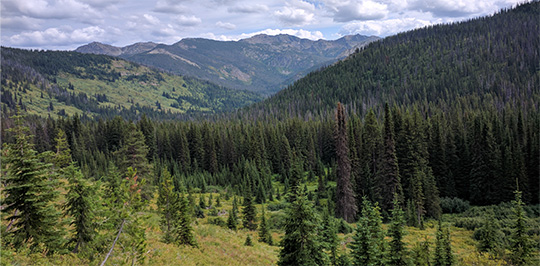Save the
Greater Salmon-Selway-Bitterroot
Help with Forest Plan Comments
Become familiar with the process

Getting involved in this planning process will help you when forest planning comes to our area.
We recommend you take an issue that is important to you and research and comment on it. You can comment multiple times.
So you can pick more than one issue.
Help save the Greater Salmon Selway Bitterroot
For more info on the plan visit
www.friendsoftheclearwater.org/forest-plan
Talking Points
You can comment multiple times on different issues. It is best to go with issues that you know and care about for commenting.
Issue: QUANTIFIABLE STANDARDS
The current plans have measurable, quantitative standards. For example, streams have fishery habitat potential percentages based on cobble embeddedness, or elk habitat effectiveness calculations, or minimum percentages of old growth that the agency must preserve drainage-wide. The new plan has no such quantitative standards. Instead, to achieve the “desired condition of “ecological conditions capable of supporting self-sustaining populations of native species,” a standard is to maintain the desired condition or to not “retard attainment of desired conditions” without more information, or to use “best management practices,” which offers no guarantees other than that the Forest Service tried.
Discussion point: Why measurable, quantitative standards are important.
Issue: VOLUME OF TIMBER TO BE LOGGED
The current plans permit timber harvest 50-60 million board feet annually for the forests. In the agency’s "natural processes dominate over anthropogenic influences" alternative (Alt Z), the alternative that is supposed to be the most environmentally friendly and ecologically driven, you propose to increase logging levels from 50-60 million bf to 60-80 million board feet (by 1/3). The other alternatives offer increased departures that allow up to FIVE TIMES more logging than the current plans.
Discussion point: Your opinion on whether the Forest Service should increase logging levels or consider alternatives that reduce logging from current levels and the environmental problems with such an increase in logging.
Issue: CONSIDERING THE CITIZEN-SCIENCE ALTERNATIVE
When the Forest Service was developing alternatives for the revised forest plan (over five years ago), Friends of the Clearwater developed and submitted a citizen-science alternative, which is an alternative that uses the best science to create measurable, quantifiable standards for the next forest plan. The Forest Service received over 10,000 comments in support of this alternative. Yet, the Forest Service has ignored this alternative and has refused to consider it. The Forest Service did develop an alternative around a county’s desire to radically increase logging levels, however.
Discussion point: Why the Forest Service should consider the citizen-science alternative.
Issue: CLIMATE-CHANGE MITIGATION AND FOREST PRESERVATION
The greenhouse gas emissions that humans generate are the leading cause of the earth’s rapidly changing climate. The of the top sources of greenhouse gas emissions are from burning fossil fuels and deforestation, which includes logging and clearcutting. The Forest Service’s environmental impact statement for the forest plan fails to discuss this. It instead states that we are in a natural warming period.
Discussion point: Why the Forest Service needs to recognize the human factors causing global warming and how the Forest Service will contribute to warming with every one of the increased logging alternatives.
Trees can capture and store carbon dioxide, reducing carbon dioxide in the atmosphere—it is called carbon sequestration. Pacific Northwest Forests can sequester more carbon than other forests in the West.1 The increased logging in all of the alternatives will reduce the potential of the Nez Perce-Clearwater National Forests to mitigate global warming.
Discussion point: Why the Forest Service should consider a reduction in logging in these forests to mitigate the impacts of global warming in the Pacific Northwest?
Issue: PLANNING FOR THE RECOVERY OF THE GRIZZLY BEAR
The current forest plans acknowledged the potential for grizzly bears to return to the Clearwater. Several grizzlies have shown up in the last couple of years. The Fish and Wildlife Service just sent the Nez-Clear forest supervisor a letter stating that the agency must consult with the FWS on grizzly bears for projects and planning. But, mere consultation is not enough because the draft forest plan fails to even mention grizzly bears, much less discuss migration corridors and the habitat necessary for grizzly bear recovery.
Discussion point: The forest plan should address grizzly recovery and the habitat needs that entails.
Issue: PLANNING FOR THE RECOVERY OF STEELHEAD
The current plan has quantifiable, measurable standards for fisheries, such as maximum allowed cobble embeddedness (rocks and pebbles that are not implanted in dirt and silt) and 300-foot buffers between streams and logging. Steelhead and salmon need unburied pebbles and rocks so they aren’t hatched into a tomb they cannot escape and they have safe places to hide when they are fries. This new plan has no quantifiable standards for the quality of fish habitat and reduces the logging buffers to 150-feet between streams and logging.
Discussion point: The need for quantifiable fishery standards that will prevent degradation of salmon and steelhead habitat and keeping buffers between streams and logging at 300 feet.
Issue: AN ALTERNATIVE THAT RECOMMENDS ROADLESS AS WILDERNESS
Roadless areas often have clean air, clean water, undisturbed soil, and habitat for threatened and endangered species because they have no roads and haven’t been logged. This revised plan has nothing that would protect these areas from the maniacal logging alternatives and the roads that would need to be built to reach those logs. Why not protect the few roadless areas we have left in the Lower 48 U.S.?
Discussion point: Why the Forest Service should consider an alternative that recommends all roadless areas for Congress to designate as wilderness.
Issue: THE PLAN DOESN’T PROTECT OLD GROWTH
The current forest plans have specific management areas that are set aside to manage for old growth and where logging is not allowed. This new plan has three management areas, allowing logging across all growth, prohibiting it only in some places if the Forest Service can conclude that logging would not “likely modify the characteristics” of old growth for more than 10 years. This is an incredibly squishy, qualitative conclusion that is cannot hold the Forest Service accountable for its actions. Species like the fisher, the pileated woodpecker, and goshawk depend upon old growth.
Discussion point: Support for and reasons why the revised forest plan should KEEP management areas that are specifically managed with the goal of preserving old growth (which means protection from logging).
Issue: TOO FEW MANAGEMENT AREAS
The Nez Perce Forest Plan has about 26 management areas. The Clearwater Forest Plan has about 17 management areas. Each of these management areas manage for something specific. The Nez Perce forest plan has a management area for timber, where the goal is timber production, and a management area for old-growth, where the goal is for old-growth dependent wildlife and logging is not allowed. This revised forest plan has three management areas. One management area has federally designated Wilderness and Wild and Scenic Rivers, so the Forest Service cannot legally log in these areas. However, the other two management areas (Management Area 2 and Management Area 3) allow logging—no place is safe.
Discussion point: Support for and reasons why the forest plan should have a variety of management areas and how the agency should change any of the current management areas.
DEADLINE IS APRIL 20, 2020. Visit www.friendsoftheclearwater.org/forest-plan for information on how to submit your comments by email, mail, or online.
